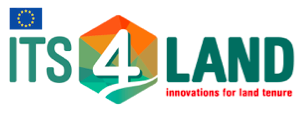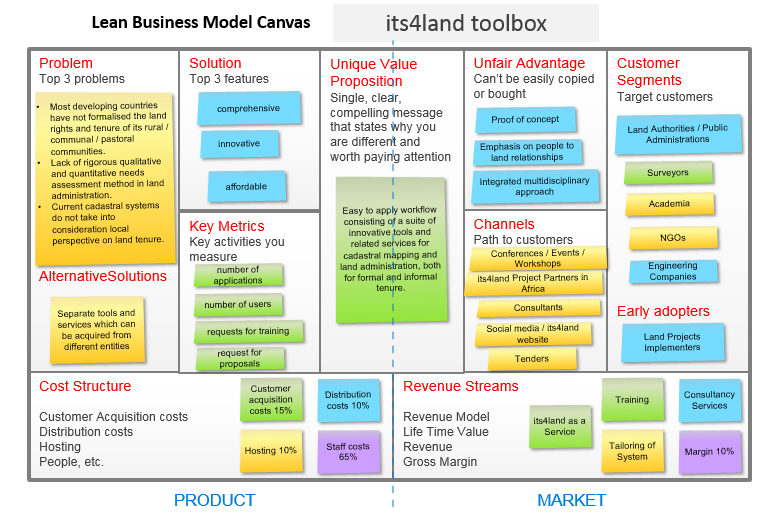its4land business model
The its4land toolbox is the joint effort of different project partners, academic and private enterprises. Hence marketing and commercialising the toolbox is best undertaken with a new legal entity which needs to be established. On the basis of this commercialisation approach the Lean Business Model would be ideal because it is best suited to start-ups. It focuses on What Works and puts its emphasis on delivering customer value. With the Lean Business Model resources can be deployed under a controlled situation thus resources are utilised in the most efficient way possible. In addition, with minimal capital investment, lean start-ups are heavily reliant on organic growth. That is, the reinvestment of profits gained from early stage development will enable the new business entity to scale up its operations in a more controlled manner without sacrificing on the levels of quality.
By applying the Lean Business Model the relevant canvas has been compiled for the its4land toolbox featuring the nine basic blocks that describe the problem, the solution, the key metrics, the unique value proposition, the unfair advantage, the channels, the customer segments, the cost structure and revenue streams.
This model is usually utilized to validate concepts. In the case of the its4land toolbox it will bring the software tools to the technology readiness levels 8 and 9 and beyond.
The following describes in brief the business model which the its4land toolbox can offer to the land administration community.
The problem:
- Most developing countries have not formalised the land rights and tenure of its rural / communal / pastoral communities.
- Lack of rigorous qualitative and quantitative needs assessment method in land administration.
- Current cadastral systems do not take into consideration the local perspective on land tenure.
Currently alternative solutions on offer are separate tools and services which can be acquired from different entities, ie not a one stop shop.
The following revenue streams are envisioned:
- Cloud services: selling access to the Publish and Share Platform in the Amazon Cloud / or some other cloud to customers wanting to use the its4land toolbox in a safe and working environment.
- Implementation services: Some customers might want to download specific its4land tools such as Smart Sketchmap or Semi-automatic Visible Boundaries Delineator or even the Publish and Share Platform from the cloud to install and run on their own infrastructure. Here customization and configuration of the its4land tools for a specific project, paid by the customer who wants to use them either on his/her own operating infrastructure or on the service provider’s infrastructure.
- Integration services: Integration of additional – generic or client specific – tools into the Publish and Share Platform. When paying for the integration of their tools, customers benefit directly from the superior computing power of the platform and the ease of exchanging data with the tools already available in the platform, and at the same time they help to make the platform more encompassing and attractive for yet additional customers.
- Support Services: Various forms of paid support services can be envisaged, from a telephone hotline to regular support- or co-working-sessions with the clients staff
- General consulting services in land projects.
The licencing model of the software tools of the toolbox will be in accordance with the Massachusetts Institute of Technology (MIT) licencing model because it fits the nature of the software development which is based on open source software.
Thus a good revenue stream for the its4land toolbox is to sell consulting and implementation services, including support and integration, as well as geocloud services.
Here it is important to have an independent legal entity as the service provider. The legal entity can operate and run more than one platform. Users then pay for the services. This could be a flat rate (monthly, annual, quarterly etc.). Of importance is the number of customers which could be won to use the toolbox, the more customers the higher the revenue.


Recent Comments